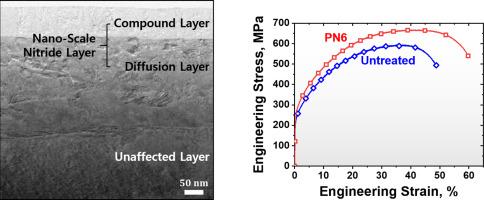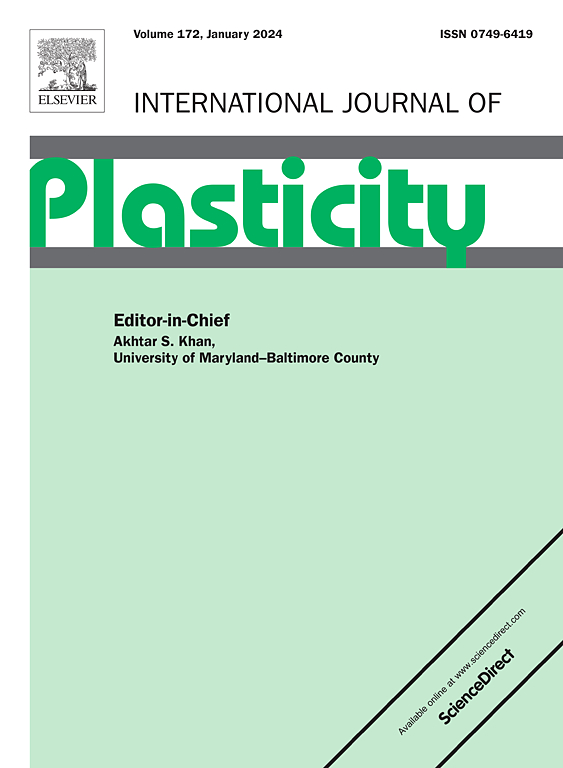Strategic enhancement of CoCrFeMnNi high-entropy alloy mechanical properties through a high-strength nano-scale nitride layer without geometrical or tolerance constraints
IF 9.4
1区 材料科学
Q1 ENGINEERING, MECHANICAL
引用次数: 0
Abstract
Plasma nitriding is a class of surface treatment method that improves wear, corrosion, and fatigue properties along with the benefits of excellent geometry freedom and minimal dimensional distortion. Yet, previous plasma nitriding studies related to tensile properties have mostly compromised strength or ductility mainly due to grain growth or the brittle nature of bulky micrometer-scale nitride layer. We propose a strategy to simultaneously improve mutually exclusive strength and elongation through a high-strength nano-scale nitride layer fabricated via plasma nitriding, overcoming the typical trade-off relationship; for example, ultimate tensile strength and uniform elongation were improved by ∼74.6 MPa and ∼7.9 %, respectively. Using extraordinarily controlled processing parameters (e.g., low-pressure, short-time, warm-temperature), we successfully produced CoCrFeMnNi HEA with a nano-scale nitride layer of ∼291.9 nm near the surface without any change in grain size. The enhanced mechanical properties of the plasma nitrided CoCrFeMnNi HEA are attributed to the combined effects of pre-existing dislocation density, high-strength nano-scale nitride layer, and compressive residual stress. This work introduces an innovative approach to nano-scale hard regions, providing a novel framework for post-processing strategies ranging from fundamental research to various industrial applications.


通过无几何或公差约束的高强度纳米氮化层战略性地增强CoCrFeMnNi高熵合金的力学性能
等离子氮化是一类能改善磨损、腐蚀和疲劳性能的表面处理方法,同时还具有出色的几何自由度和最小尺寸变形的优点。然而,以往与拉伸性能有关的等离子氮化研究大多会损害强度或延展性,这主要是由于晶粒长大或大块微米级氮化层的脆性造成的。我们提出了一种策略,通过等离子氮化制造高强度纳米级氮化层,同时提高互斥的强度和伸长率,克服了典型的权衡关系;例如,极限拉伸强度和均匀伸长率分别提高了 ∼ 74.6 MPa 和 ∼ 7.9%。利用超常控制的加工参数(如低压、短时间、高温),我们成功制备出了在表面附近具有 ∼291.9 nm 纳米级氮化层的 CoCrFeMnNi HEA,且晶粒大小没有发生任何变化。等离子氮化 CoCrFeMnNi HEA 机械性能的增强归因于预先存在的位错密度、高强度纳米级氮化层和压缩残余应力的共同作用。这项工作为纳米级硬质区域引入了一种创新方法,为从基础研究到各种工业应用的后处理策略提供了一个新的框架。
本文章由计算机程序翻译,如有差异,请以英文原文为准。
求助全文
约1分钟内获得全文
求助全文
来源期刊

International Journal of Plasticity
工程技术-材料科学:综合
CiteScore
15.30
自引率
26.50%
发文量
256
审稿时长
46 days
期刊介绍:
International Journal of Plasticity aims to present original research encompassing all facets of plastic deformation, damage, and fracture behavior in both isotropic and anisotropic solids. This includes exploring the thermodynamics of plasticity and fracture, continuum theory, and macroscopic as well as microscopic phenomena.
Topics of interest span the plastic behavior of single crystals and polycrystalline metals, ceramics, rocks, soils, composites, nanocrystalline and microelectronics materials, shape memory alloys, ferroelectric ceramics, thin films, and polymers. Additionally, the journal covers plasticity aspects of failure and fracture mechanics. Contributions involving significant experimental, numerical, or theoretical advancements that enhance the understanding of the plastic behavior of solids are particularly valued. Papers addressing the modeling of finite nonlinear elastic deformation, bearing similarities to the modeling of plastic deformation, are also welcomed.
 求助内容:
求助内容: 应助结果提醒方式:
应助结果提醒方式:


